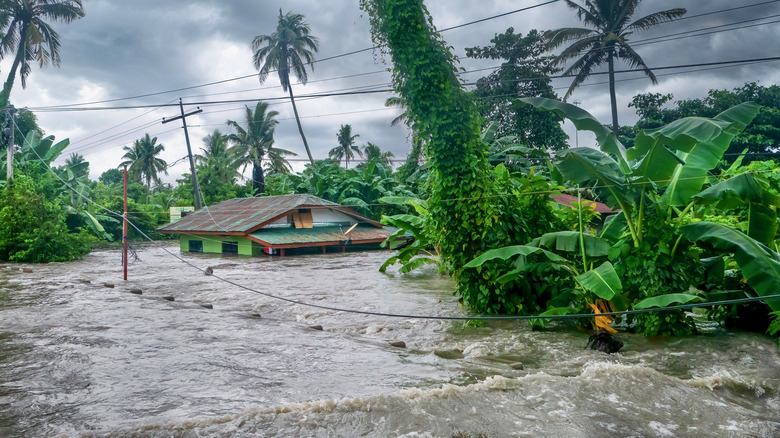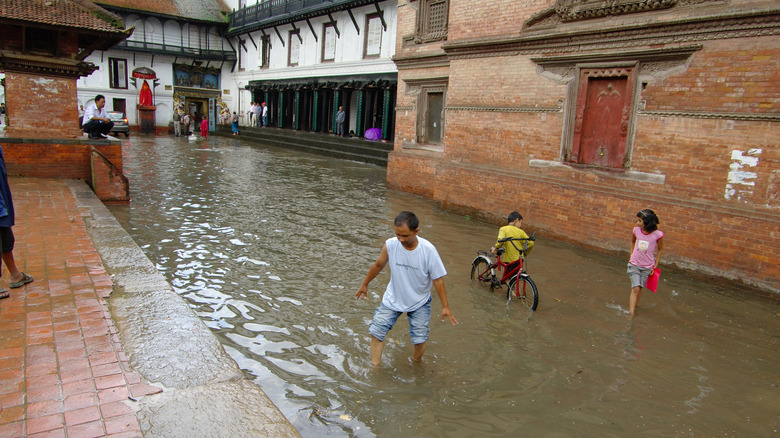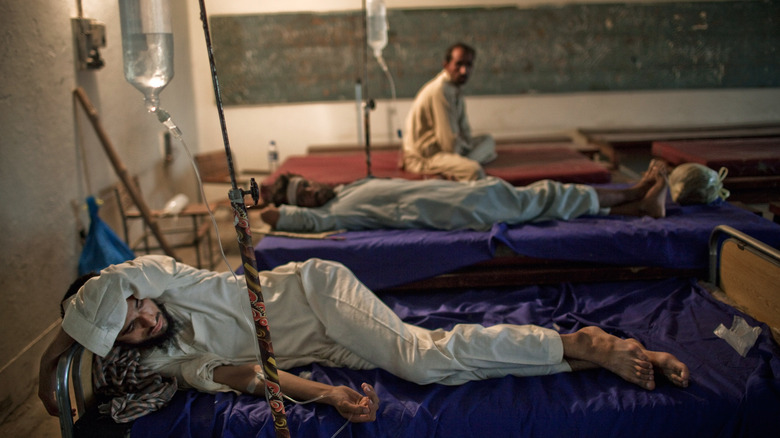The Worst Monsoon Disasters In History
Natural disasters are terrifying events, and their aftermaths are frequently seared into the minds of those who have to experience them. Whether that's the rubble left behind in the remains of a flattened city after an earthquake, or the sight of a tornado touching down amidst dark and stormy skies, there's no debate that disasters like these leave destruction in their wakes.
To get a little more specific, though, while once-in-a-lifetime events often make front page news, the cycles of destruction that come from seasonal storms like monsoons are no less devastating. Monsoons are winds that change direction seasonally and mostly known for causing heavy rainfall that can sometimes be devastating.
On multiple occasions, monsoons have been the root cause for massive instances of lost lives, uprooting people and destroying property, and sometimes even leading to other effects that are perhaps less obvious. There are countless tales of monsoon-related disasters, but here are a few of the worst ones.
South Asia, 2004
The monsoon season isn't inherently bad. After all, when it's predictable and not especially excessive, the rains bring precious water that's needed to be able to grow crops. But when the monsoons aren't predictable, well, that's where problems can arise — heavy rains can prove to be incredibly harmful, forcing thousands of people from their homes.
The monsoon season of 2004 is a good example of one of those unpredictable storms, with multiple parts of South Asia getting hit pretty hard. Starting in June, an especially rainy season led to flooding that swept its way through hundreds of towns, ultimately driving all the residents — about a quarter of a million people — of those towns out of their homes. Things only got worse from there, though, with the death toll rising as the weeks passed. There were instances where over a hundred bodies were found in a single day, some due to more predictable causes like drowning, but others even lost their lives to slightly less predictable things — like lightning, for one. By August, the number of deaths had risen to just under 2,000, though there were thousands more who were suffering from various illnesses, and many millions of others who suddenly found themselves in need of food that couldn't readily be found.
Southeast Asia, 2011
The 2011 monsoon that hit Southeast Asia was a complex and serious storm. The total number of deaths came out to somewhere just above 1,000, which wasn't the deadliest monsoon season ever seen. But, that said, there's something awfully unique about this particular storm.
Here's the general story, though: In the summer of 2011, floods hit all across Southeast Asia, affecting a whole host of countries including Thailand, Cambodia, Vietnam, the Philippines, and others. Hundreds of people died in each of those countries, with a large percentage of those deaths being children. Millions of acres of farmland and crops were also destroyed in the process, raising concerns about just what the food situation might look like in the future.
Strangely, though, the actual monsoon itself wasn't especially severe when compared to prior storms that would typically hit around the same time of year. But don't be fooled, because it wasn't a normal monsoon; specifically, the intensity of this storm could be attributed to the fact that it was a confluence of unfortunate events. There was the normal monsoon season, but there were also other storms that happened to be hitting Asia at the exact same time. It just so happened that those other storms migrated further inland, crossing paths with the monsoon system and, quite possibly, making it even worse than usual.
Pakistan, 2022
Monsoons and the massive amounts of damage that they can wrought are far from a thing of the past, at least if the flooding in Pakistan during the summer of 2022 is anything to go by. It started out more or less as you'd expect, with rainfall that began around the middle of June. But this would turn out to be no normal amount of rain. After about two months of continuous rainfall and the subsequent flooding, the reports were looking bleak. By late August, there were over 1,000 deaths reported, with over 100 of those deaths coming in the space of only 24 hours. Then there were the nearly million people (or more) who were otherwise affected by the standing water and forced to leave their homes and the millions of acres of land that were left completely ruined, unable to support agriculture.
Less than a month later, things were looking significantly worse. By laate-September, all of those numbers reported back in August had skyrocketed, growing to some 1,600 deaths, over 12,000 injuries, and millions of people who had been displaced as a result of the destruction. But it was even more bleak than that; standing water isn't exactly great when it comes to public health, and there were rising cases of illnesses like typhoid and malaria, all while the health system had nowhere near enough resources to adequately deal with all the problems to come.
India, 2019
Going through history, there are more than a few tropical storms that have wreaked havoc on India over the years, but 2019 managed to stand out, proving to bring the worst weather that the country had seen in 25 years.
To lay it out pretty simply, over 1,600 people were killed by this particular natural disaster, which, on its own, managed to dump more rain than the 50-year average. And that was all in the span of a single monsoon season. Photos from Insider only further illustrate the situation: cars almost entirely submerged, people rowing boats down the streets rather than driving, hospital beds just barely elevated past the surface of brown water, and whole groups of people wading through the rivers or using boats to travel the streets. And to make it all worse? Government assistance was inadequate, to put it lightly, and the people were feeling pretty helpless in light of it all.
What's more, this particular monsoon stuck around longer than those that had hit in the past, lingering all the way until October — about a month more than usual. As for why? Well, there's climate change to thank. In short, the summer monsoon season tends to coincide with warmer weather, and with climate change generally raising the temperature at the tail end of the summer, the monsoon season was extended accordingly.
India, Bangladesh, and Nepal, 1993
When a monsoon hits and millions of people are affected, with thousands dead, you might expect the response to be very charitable — or, at the very least, government agencies stepping in and doing their best to mitigate the damage. But sometimes, instead of all of that, politics gets involved instead.
In the summer of 1993, heavy rains in India led to the subsequent flooding of rivers in the region, but in this case, those rains didn't affect only India. Rather, that flood water seeped beyond the borders of the country, covering wide swaths of land across Nepal and Bangladesh as well. Millions of acres of farmland were destroyed across all three countries, water-borne diseases raged, food became scarce, and around 2,000 people were killed. People could only expect things to get worse with time — even when the waters receded, none of this changed the fact that more and more people were moving into the dangerous flood plains.
But that's not what was on the mind of the respective governments of these three countries. As The New York Times explains, the government of Bangladesh actually blamed politicians in India and Nepal for everything, essentially saying that they were the victims of poor management by the other two nations. And this was just one part of existing problems, with India long having control of freshwater flow into Bangladesh and Nepal being generally opposed to listening to any of India's requests.
Pakistan, 2010
Multiple feet of water completely flooding towns is a pretty terrifying prospect. The danger inherent with that volume of water is something that doesn't really need to be explained; people being swept away or drowned is easy enough to conceptualize. But water can be dangerous for more reasons than those.
Here's the context: In July 2010, Pakistan was hit by multiple instances of heavy rains, with an article published by PLOS Currents noting that the people of the country were sometimes given only a few hours to prepare before the time when floods were expected to hit. A week after the first rains, things truly took a turn for the worse, though, as major rivers began to flood, at which point, the water couldn't be stopped. District after district was overtaken by the raging waters, and millions of people were forced to flee from their homes. All told, nearly 2,000 people were killed as a result of the flooding, and approximately another 3,000 were injured in one way or another.
But the scary part comes in the propagation of disease that came as a result. According to the World Health Organization, over 100,000 cases of both diarrhea and skin infections were reported in the direct aftermath of the flooding. An article in the Asian Pacific Journal of Tropical Biomedicine further suspects that the water and the poor hygiene could eventually lead to far worse diseases including malaria and hepatitis.
India, 1978
In the late summer of 1978, India saw the worst storms and flooding it had seen in a long time, but that wasn't even the worst of it. The fact that this monsoon specifically hit in the later part of the summer might have contributed to the destruction that would eventually follow. After all, monsoon season should've almost been over by that time, but, well, nature apparently had something to say about that.
Following minimal warnings issued by the government, much of New Delhi found itself cut off from the rest of the country as a result of the floodwaters ruining roads and infrastructure. Worst of all, parts of the city were quite literally underwater — as in, under about 18 feet of water. And, frankly, that's a number that really doesn't require any sort of explanation to make it clear how terrifying the situation was. Some 15 million people were affected in some way by the floods, 2 million of whom had found themselves homeless and forced to move to drier lands. Early reports also mentioned thousands missing, as well as over 500 confirmed dead.
But it didn't end there. After a few days, reports mentioned nearly a thousand deaths, as well as villages completely destroyed. And ultimately, the number swelled in a massive way, growing to a reported 3,800 dead.
India, 2013
Just a couple of days can change everything, as was the case during the summer of 2013 in India. Starting on June 13, especially heavy rains started hitting North India. And while that could've been a problem on its own, worse omens were on the horizon. Quickly those rains catalyzed a flash flood. The effects were devastating enough that exact deaths couldn't even be adequately counted, with early accounts giving numbers around 600, but then a harsher reality set in. Far more than 600 hundred people were missing, and for all anyone knew, they were long dead: buried under debris, swept miles away by the waters, or some other fate entirely.
Ultimately, the Indian government declared that all 5,700 missing people would be assumed dead. There were also the damages that came from the literal thousands of villages that were affected by the floodwaters and the landslides, with some of those villages being completely washed away, and others being nearly inaccessible due to blocked and broken roads.
Hundreds of millions of dollars in damages followed, and there's a chance tourism is at least partially to blame. See, that particular region in the Himalayas had begun to attract more and more tourists and pilgrims, leading to increased construction. Neither of those factors were positive ones in the face of a monsoon; if not for tourism, there might have been fewer people killed.
Bangladesh, 1974
The destructive power that can come from a monsoon on its own is nothing to scoff at. That much is pretty clear. But in some cases, things are a bit more complicated than merely the effects of floodwaters and storms. And when you're talking about that, Bangladesh in the early 1970s is a pretty good place to look.
See, the 1970s weren't the best decade for the country, characterized by political turmoil and instability, to put it generally. Natural disasters had already brought political problems to the foreground, and storms and subsequent flooding in July and August of 1974 only made things worse. Entire fields of crops were rendered useless, and so not only were a bunch of jobs ripped away from the population, but food also became a problem.
And that's really what the year 1974 is known for when it comes to Bangladesh: the famine. Government food kitchens did pop up, but even when their numbers increased, they still weren't enough to keep the people adequately fed. Most everyone had to survive on (almost literal) meager scraps of food, worried about their own ability to make it through the day. The government had even just consigned itself to the idea that thousands would die of starvation. And the analyses provided later are in line with the dismal situation; an article from The Bangladesh Development Studies states that some reports attribute around 250,000 deaths to the effects of the famine.
Thailand, 1983
When it comes to the worst monsoons in history, it only makes sense to make reference to the monsoon cited by Guinness World Records to be the deadliest in history: Thailand's storm of late 1983 took some 10,000 lives. But just what were the specifics behind the storm?
Basically, the disaster was catalyzed by the rather unfortunate circumstance of two different storms — tropical storms Herbert and Kim — both hitting Thailand at the same time. By October 20, over a foot of rainfall had led to more than 20 reported deaths, but that was not the end of the problems. Far from it. See, Bangkok was primed for maximum damage from floods. The city itself is not only flat but also sinking further and further below sea level as the years go on. Also urban development had blocked off the canals that were meant to direct floodwaters away from the city.
All of that taken together, the city ended up being effectively underwater for half of 1983 — from August until about the end of the year. About $400 million was reported in damages, as well as tens of thousands of cases of disease as a result of the standing water. Then there were the deaths, which came about due to anything from electrocution to being swept out to sea.










